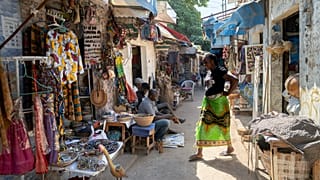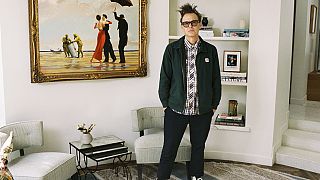Art
From Switzerland, Thailand, Argentina, South Africa or Italy, about fifty international artists created their works in situ in a 29,000 m2 industrial wasteland for the 15th Biennale d’art contemporain de Lyon, in the centre-east of France.
This year’s event “is taking on an unprecedented scale”, underlines the artistic director of the Isabelle Bertolotti Biennale.
For its 15th edition, from Wednesday to January 5, 2020, this contemporary art event moved to a location that offers five times more exhibition space, in the former Fagor-Brandt household appliance factories, the former jewel of Lyon’s industry.
Using “unoccupied or wasteland sites should make it possible to test innovative projects before launching them definitively”, explains Urban Planning Assistant Michel Le Faou.
The team at the Palais de Tokyo, a museum of modern and contemporary art in Paris, is in charge of curating the 2020 edition and has travelled the world to find the artists on display.
Coming from Bangkok, Buenos Aires, New York, Johannesburg, Mexico City, Moscow or Rome, but also from France, artists were invited to design “in situ” works taking into account the history and architecture of the places.
The region’s companies have taken part in this challenge, from metallurgy to chemistry, from textiles to construction and the automotive industry, from cutting-edge technologies to traditional know-how.
The result of this artistic-industrial fusion: the labyrinthine stainless steel pipes of the Korean Yona Lee, who lives in New Zealand, the mechanical centaur of the Italian Nico Vascellari, or sculpted digestive systems, a reinvented tunnel boring machine, stretched fabrics…
Artworks on display
Swedish artist Malin Bülow offers a vast performance, “Elastic Bonding”, featuring dancers trapped in suspended textile membranes, which appear to be extensions of their skin and blend into the building’s architecture.
Frenchman Jean-Marie Appriou unveils a monumental installation in cast aluminium that unfolds in space like a brambles, while Rebecca Ackroyd of Britain confronts her sculptures of mutant and asexual bodies with the XXL scale of the Fagor factories.
Simphiwe Ndzube, a South African artist living in Los Angeles, stages two processions of hybrid sculptures, echoing the themes that haunt his work, apartheid and post-colonialism, while forging links with the Canut revolt in Lyon.
His compatriot Bianca Bondi imagines a “crystallized kitchen” under a coat of salt, a reference to the production of household appliances at Fagor Factories.
Fernando Palma Rodriguez’s enigmatic installation “Tetzahuitl” features 43 children’s dresses that slowly climb up and down using a robotic system.
Mysterious also “Evian Waters” by Swiss artist Pamela Rosenkranz: talcum powder and pink make-up powder fill a circle on the ground. Every day, mineral water will be poured into it, creating gullies and craters in the mixed materials.
Further on, the Korean Minouk Lim invites the visitor along a phosphorescent canal where a giant pinball machine is advancing. At the water’s edge, a traditional Korean costume seems to be waiting for a laundress.
Outside, a painting by the American Stephen Powers animates the facade.













02:19
Milan exhibition highlights 3,000 years of Olympic history
01:00
London's iconic landmarks recreated in gingerbread at charity exhibition
02:20
Hong Kong: New exhibition marks 85th birthday of late martial arts icon Bruce Lee
02:20
Met museum unveils ‘Divine Egypt’ exhibition on ancient gods
01:00
Expo 2025 Osaka closes after six months and 28 million visitors
02:20
New exhibition celebrates Yves Saint Laurent’s love of dogs